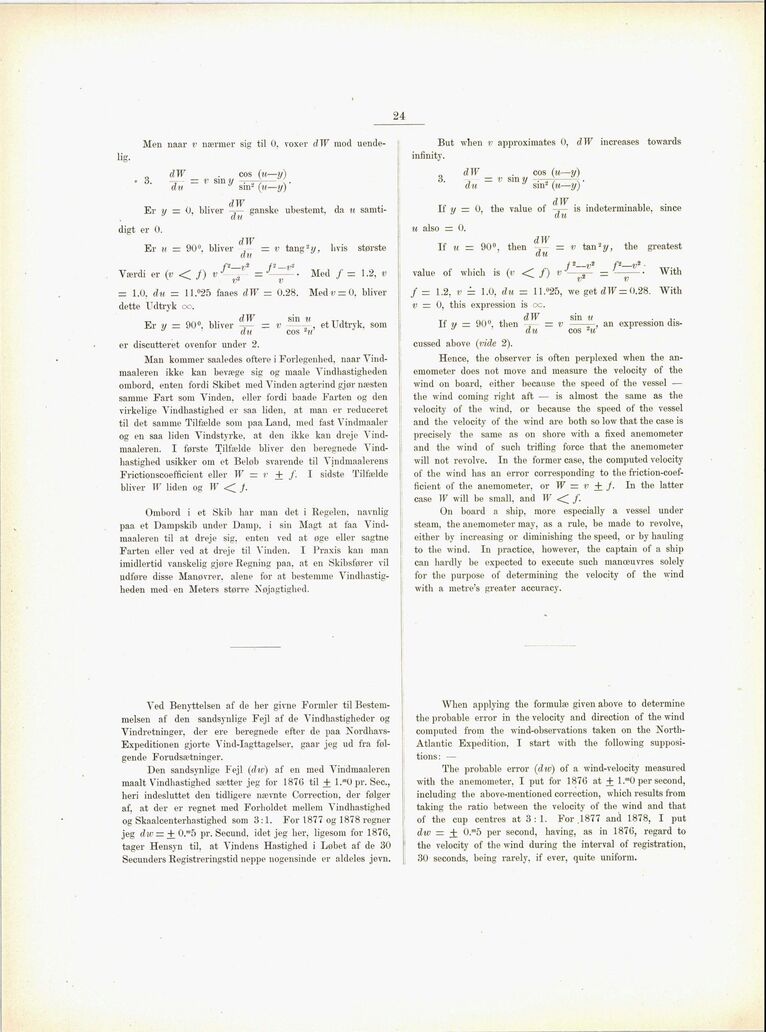
Full resolution (JPEG) - On this page / på denna sida - Sidor ...

<< prev. page << föreg. sida << >> nästa sida >> next page >>
Below is the raw OCR text
from the above scanned image.
Do you see an error? Proofread the page now!
Här nedan syns maskintolkade texten från faksimilbilden ovan.
Ser du något fel? Korrekturläs sidan nu!
This page has never been proofread. / Denna sida har aldrig korrekturlästs.
24
Men naar v nærmer sig til 0. voxer dW mod uende-
dW . eos (u—y)
- = v sin?/ -r-3-7—
dv sm- (u—y)
Er y :
digt er 0.
dW
Er u = 90°, bliver = v tang-?/, hvis største
Værdi er (v /) v
Med / = 1.2, v
— 1.0, du = ll.°25 faaes dW = 0.28. Med v = 0, bliver
dette Udtryk oo.
Er y = 90°. bliver ~ = v ®m J-. et Udtryk, som
J ’ du eos V J ’
er discutteret ovenfor under 2.
Man kommer saaledes oftere i Forlegenhed, naar
Vindmaaleren ikke kan bevæge sig og maale Vindhastigheden
ombord, enten fordi Skibet med Vinden agterind gjør næsten
samme Fart som Vinden, eller fordi baade Farten og clen
virkelige Vindhastighed er saa liden, at man er reduceret
til det samme Tilfælde som paa Land, med fast Vindmaaler
og en saa liden Vindstyrke, at den ikke kan dreje
Vindmaaleren. I første Tilfælde bliver den beregnede
Vindhastighed usikker oin et Beløb svarende til Vindmaalerens
Frictionscoefficient eller W = v + /. I sidste Tilfælde
bliver TI’ liden og W j.
Ombord i et Skib har man det i Regelen, navnlig
paa et Dampskib under Damp, i sin Magt at faa
Vindmaaleren til at dreje sig, enten ved at øge eller sagtne
Farten eller ved at dreje til Vinden. I Praxis kan man
imidlertid vanskelig gjøre Regning paa, at en Skibsfører vil
udføre disse Manøvrer, alene for at bestemme
Vindhastigheden med en Meters større Nøjagtighed.
But when v approximates 0, dW increases towards
infinity.
3.
d W
du
— v sm y
eos (m—y)
sin8 (u—y)’
dW .
If y rz 0. the value of -=— is indeterminable.
du
; also zz 0.
dW
If u = 90°. then
du
v tan -y, the greatest
f*._f 2_-
value of which is (v f) v —— -•
\ / VS v
f = 1.2, v = 1.0, du = ll.°25, we get dW = 0.28.
v = 0, this expression is og.
sin u
With
With
dW
If y = 90°. then / = v
du eos ■
an expression dis-
cussed above (inde 2).
Hence, the observer is often perplexed when the
anemometer does not move and measure the velocity of the
wind on board, either because the speed of the vessel —
the wind coming right aft — is almost the same as the
velocity of the wind, or because the speed of the vessel
and the velocity of the wind are both so low that the case is
precisely the same as on shore with a fixed anemometer
and the wind of such trifling force that the anemometer
will not revolve. In the former case, the computed velocity
of the wind has an error corresponding to the
friction-coefficient of the anemometer, or W = v + /. In the latter
case W will be small, and W f.
On board a ship, more especially a vessel under
steam, the anemometer may, as a rule, be made to revolve,
either by increasing or diminishing the speed, or by hauling
to the wind. In practice, however, the captain of a ship
can hardly be expected to execute such manoeuvres solely
for the purpose of determining the velocity of the wind
with a metre’s greater accuracy.
Ved Benyttelsen af de her givne Formler til
Bestemmelsen af den sandsynlige Fejl af de Vindhastigheder og
Vindretninger, der ere beregnede efter de paa
Nordhavs-Expeditionen gjorte Vind-Iagttagelser, gaar jeg ud fra
følgende Forudsætninger.
Den sandsynlige Fejl (div) af en med Vindmaaleren
maalt Vindhastighed sætter jeg for 1876 til + l.m0 pr. See.,
heri indesluttet den tidligere nævnte Correction, der følger
af, at der er regnet med Forholdet mellem Vindhastighed
og Skaalcenterhastighed som 3:1. For 1877 og 1878 regner
jeg dw= + 0.m5 pr. Secund, idet jeg her, ligesom for 1876,
tager Hensyn til, at Vindens Hastighed i Løbet af de 30
Secunders Registreringstid neppe nogensinde er aldeles jevn.
When applying the formulæ given above to determine
the probable error in the velocity and direction of the wind
computed from the wind-observations taken on the
North-Atlantic Expedition, I start with the following
suppositions: —
The probable error (did) of a wind-velocity measured
with the anemometer, I put for 1876 at + l.m0 per second,
including the above-mentioned correction, which results from
taking the ratio between the velocity of the wind and that
of the cup centres at 3 :1. For .1877 and 1878, I put
dw — i 0.m5 per second, having, as in 1876, regard to
the velocity of the wind during the interval of registration,
30 seconds, being rarely, if ever, quite uniform.
<< prev. page << föreg. sida << >> nästa sida >> next page >>